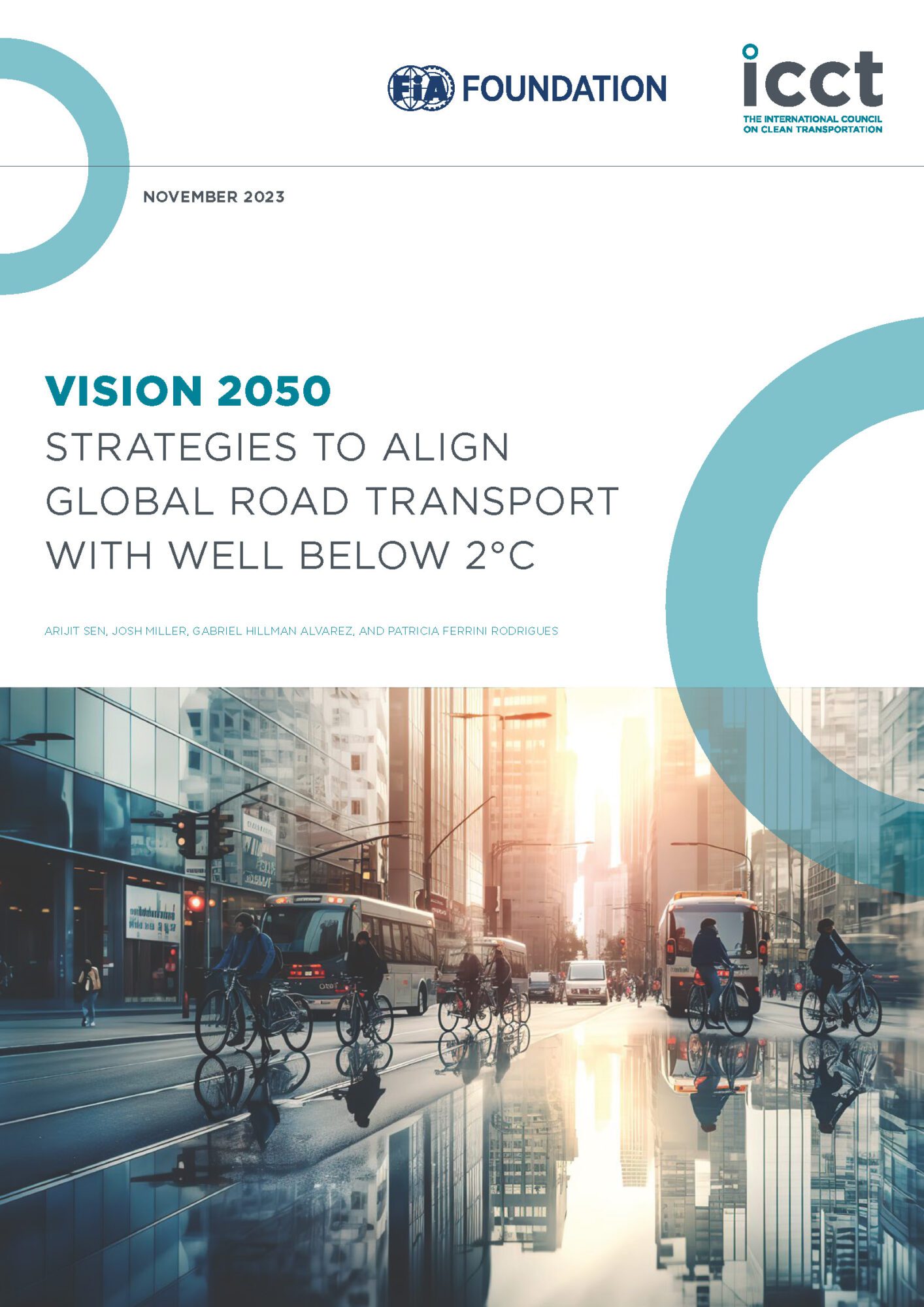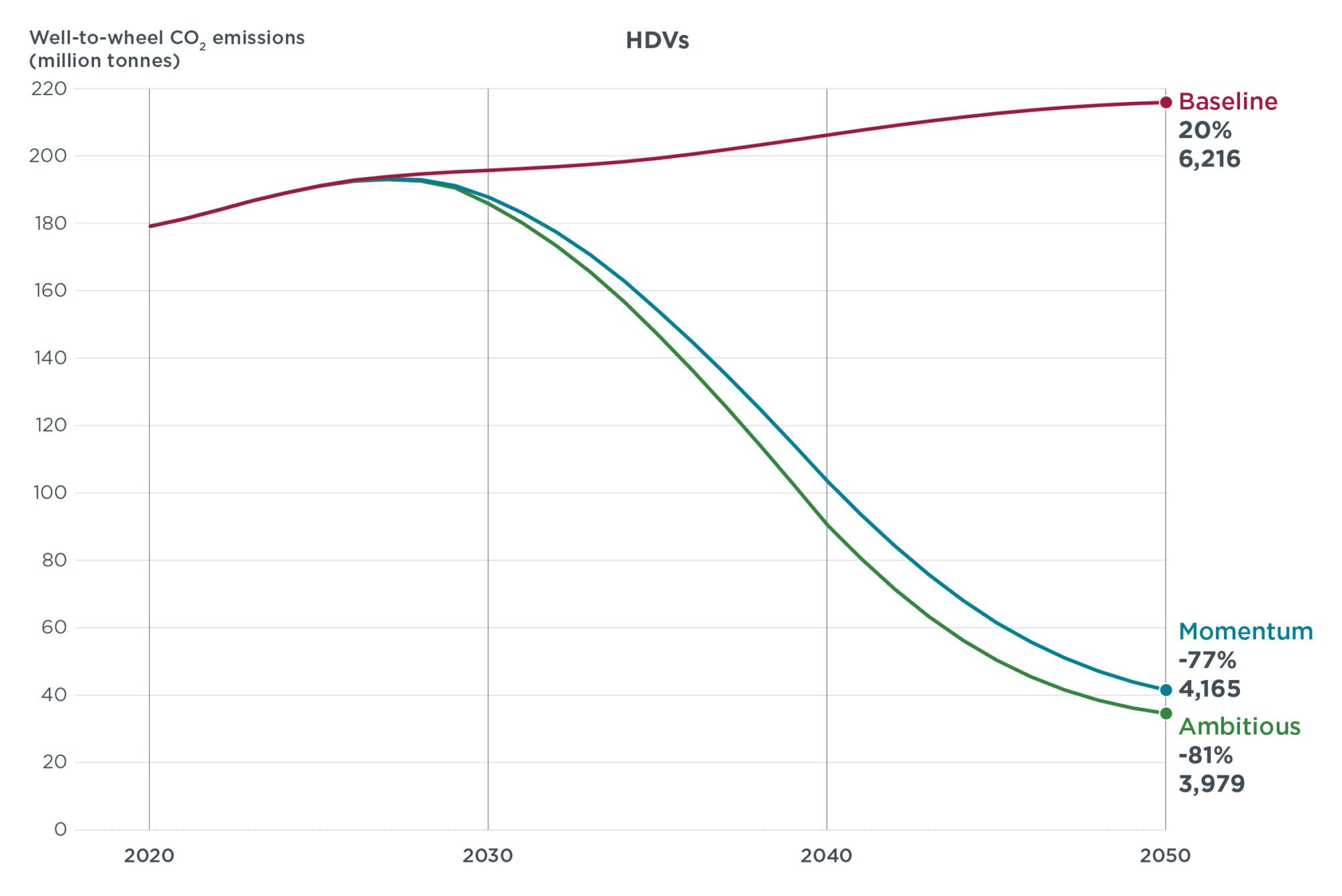Vision 2050: Update on the global zero-emission vehicle transition in 2023
Blog
Ambitious HDV regulations are key to unlocking Canada’s full decarbonization potential
When Canada finalized the Electric Vehicle Availability Standard (EVAS) for zero-emission light-duty vehicles (LDVs) late last year, it was a milestone for reducing the country’s carbon dioxide (CO2) emissions from road transport. The regulation phases out sales of new internal combustion engine (ICE) vehicles by first requiring 20% zero-emission vehicles (ZEVs) in new LDV sales in 2026 and then progressively increasing the ZEV requirement to 60% by 2030 and 100% by 2035. Setting a similarly ambitious regulation for heavy-duty vehicles (HDVs) is an important next step to put Canada on a path to achieving its goal of economy-wide net-zero emissions by 2050.
The reduction in emissions from EVAS is expected to be substantial: Our estimates indicate that implementing it would reduce well-to-wheel CO2 emissions from Canada’s LDV fleet by 82% by 2050 compared with 2020. Tailpipe emissions from all transport segments are the second-largest source of greenhouse gas emissions in Canada, and LDVs are approximately 50% of those emissions. This means that emissions from the HDV segment need to come down, as well. There are already some HDV targets in the Canada 2030 Emissions Plan (ERP), which proposes reaching 35% zero-emission medium- and heavy-duty vehicles in new sales by 2030 and 100% by 2040. But the ERP is not binding legislation like EVAS.
Setting a binding HDV regulation could continue the momentum from EVAS. Historically, Canada harmonized its vehicle regulations with those set by the United States, and the adoption of the EVAS marked the first major departure from this. The United States has not yet adopted a timeline for the phaseout of ICE sales for LDVs, but the EVAS does; the EVAS is closely aligned with California’s Advanced Clean Cars II regulation, which also requires 100% ZEV sales for LDVs by 2035. For HDVs, California’s timeline for achieving 100% ZEVs in new sales, as outlined in the Advanced Clean Fleets (ACF) rule, is 4 years earlier (2036) than the Global Memorandum of Understanding on Zero-Emission Medium- And Heavy-Duty Vehicles 2040 targets that the United States and Canada signed onto and which Canada has incorporated in its non-binding ERP.
If Canada were to craft HDV regulations that go beyond the ERP and align with California, it would mean capturing significant emissions-reduction benefits. To understand how much, let’s consider the three ZEV transition scenarios that the ICCT modeled in a recent study. The Baseline scenario reflects the current trajectory of HDV ZEV adoption in Canada, which is shaped by policies adopted at the provincial and national levels through March 2023 and factors in modest, market-led growth in ZEV sales through 2050. In the other two scenarios—Political Momentum and Ambitious—Canada realizes its goal of achieving 100% zero-emission HDV sales by 2040, but the interim targets for 2030 and 2035 differ. In the Political Momentum scenario, the intermediate sales targets for 2030 and 2035 are 37% (just above the ERP target) and 72% (based on linear interpolation), respectively. The Ambitious scenario, meanwhile, establishes intermediate targets of 60% and 88% for the same years. The emissions from these sales trajectories are in Figure 1.
In the Political Momentum and Ambitious scenarios, accelerating ZEV deployment leads to deep reductions in emissions compared with the Baseline. The Political Momentum scenario is projected to yield a 77% reduction in CO2 emissions below 2020 levels by 2050 and remove 2,050 million more tonnes of CO2 between 2020 and 2050 than the Baseline. Ramping up intermediate ZEV adoption targets, as represented in the Ambitious scenario, could yield an 81% reduction in CO2 emissions from 2020 to 2050 compared with the Baseline; this would avoid an additional 187 million tonnes of CO2 emissions compared with the Political Momentum scenario. In other words, Canada could boost cumulative CO2 emission reductions by nearly 10% by adopting higher interim ZEV targets for commercial trucks and buses on the way to 100% ZEV HDV sales by 2040. These additional emission reductions would be equivalent to taking 44.5 million gasoline-powered passenger vehicles off the road for one year.
The potential is especially significant as the risks of overshooting the 1.5°C global temperature target continue to rise. Canada’s recent milestone EVAS rule for LDVs is a pivotal step in aligning the trajectory of the country’s road vehicle fleet with its climate goals. Now there is the opportunity to design a binding ZEV regulation for HDVs in line with the targets outlined in California’s ACF regulation. Doing so would support decarbonization of Canada’s HDV fleet in line with the country’s climate goals and advance the planet toward a well-below 2°C future.
Author
Richard Kirschner
Research Fellow
Related Publications

VISION 2050: STRATEGIES TO ALIGN GLOBAL ROAD TRANSPORT WITH WELL BELOW 2°C
Emphasizes the effectiveness of ambitious zero-emission vehicle sales and age restrictions on used vehicle sales in significantly reducing cumulative CO2 emissions, along with other strategies to achieve well-below 2°C of warming.

